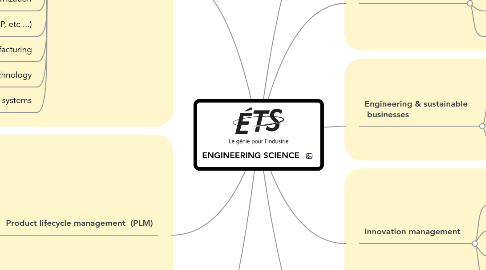
1. Logistics & production
1.1. Analysis, planning, scheduling and optimization of the supply chain
1.2. Design and planning of sustainable supply chains
1.3. Green logistics
1.4. Management and inventory optimization
1.5. Manufacturing networks and smart services
1.6. Operations Research
1.7. Optimization of transport flows
1.8. Process analysis and optimization
1.9. Production / Operations management (MRP SAP, etc ...)
1.10. Remanufacturing
1.11. RFID technology
1.11.1. Identification
1.11.2. Security
1.11.3. Traceability
1.12. Simulation and optimization of manufacturing systems
2. Product lifecycle management (PLM)
2.1. Development strategies
2.2. Digital tools improvement
2.2.1. Highly Productive Digital engineering (4D CAD & Knowledge Management)
2.2.2. Modeling software for the optimization of multiphysics processes
2.2.3. Plagiarism Detector for CFAO
2.3. Eco-design
2.4. Knowledge Management
2.5. Methods and tools for design
2.6. Systems Engineering
3. Project management
3.1. Before the project
3.1.1. Ideas management
3.2. Management of multidisciplinary teams
3.3. Planning & analysis
3.3.1. Analysis of the added value
3.3.2. Building construction project (construction, waste, commissioning, operations)
3.3.3. Feasibility analysis
3.3.4. Maturity analysis
3.3.5. Performance analysis of manufacturing systems
3.3.6. Planning (Options, Cost and Value)
3.3.7. Profitability analysis
3.3.8. Simultaneous engineering
3.4. Project management (PMI)
3.5. Risk & change management
3.5.1. Change management
3.5.2. Environmental and human impacts
3.5.3. Management of improvements
3.5.4. Re-engineering process
3.5.5. Risk assessment
4. Quality management
4.1. Management
4.1.1. Audit & standardization (ISO-9000, ISO-13485)
4.1.2. Control ranges
4.1.3. Industrial statistics
4.1.4. Process optimization
4.1.5. Process planning and modeling
4.1.5.1. Product
4.1.5.2. Service
4.1.6. Quality standards & standardization
4.2. Measurements & tests
4.2.1. 3D Metrology
4.2.2. Automated inspection (imaging, vision, artificial intelligence, pattern recognition)
4.2.3. Modeling of inspection systems
4.2.4. Non-destructive testing standard and non-standard
4.2.5. Uncertainties propagation
5. Automated documents processing
5.1. Exploration
5.1.1. Big Data
5.1.2. Data and text mining
5.1.3. Digital Image processing
5.1.4. Document analysis
5.1.5. Document interpretation
5.1.6. Pattern Recognition
5.1.6.1. Signature verification
5.1.6.2. Face recognition
5.1.6.3. Handwriting recognition
5.2. Green technologies
5.2.1. Sustainable development Telco Cloud
5.2.2. Quantification of the carbon emission reduction
5.2.3. Reducing carbon emissions through the use of cloud computing and virtualization
5.3. Management
5.3.1. Classification, archiving, automatic identification for multimedia
5.3.2. Graphical representation of data
5.3.3. Indexing data
5.3.4. Information architecture, ontology, semantic
5.3.5. Metadata
5.3.6. Multidisciplinary information technology for construction (IFC, BIM, etc ...)
5.3.7. Reuse of product development information
5.3.8. Securing content and its access
5.3.9. Suppression of engineering drawings
5.4. Storage
5.4.1. Cloud computing
5.4.1.1. Gestion & sécurité
5.4.1.2. Hadoop
5.4.2. Optimization of databases related to processes
6. Engineering & sustainable businesses
6.1. Information management
6.1.1. Informal information system between human
6.1.2. Information quality
6.1.3. Information system with software
6.1.4. Watch process and social networks
6.2. Organizational transformation
6.2.1. Aid for design of the orgtanisations
6.2.2. Collaborative management
6.2.3. Organizational architecture
6.2.4. Sustainable strategies
6.3. Technology management
6.3.1. Adoption of new technologies by employees
6.3.2. Agile method

